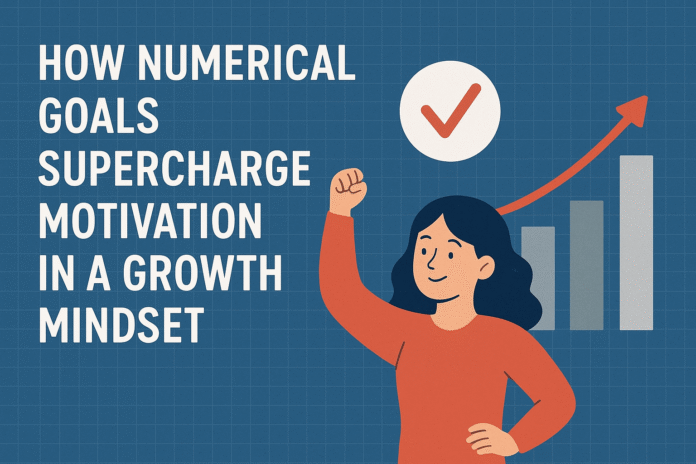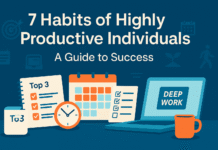Numerical goal-setting and increased motivation in growth mindset are tightly connected: specifying how much, by when, and how you’ll measure it can turn vague ambition into measurable progress and sustained effort. This article explains why measurable (numerical) goals boost motivation for people practicing a growth mindset, shows exactly how to design and implement those goals, and gives practical, beginner-friendly plans, troubleshooting tips, and a 4-week starter roadmap you can use immediately.
Who this is for: students, learners, coaches, managers, self-directed professionals, and anyone who wants to use numbers to turn learning effort into consistent progress while keeping a flexible, learning-focused mindset.
What you’ll learn: the psychological mechanisms that make numerical goals motivating for growth-oriented people; step-by-step methods for writing, implementing, and measuring numerical goals; safe progressions; common mistakes and how to fix them; a 4-week starter plan; and answers to the most common questions.
Key takeaways
- Specific, measurable numbers increase clarity, feedback, and perceived competence — all of which fuel motivation when you hold a growth mindset.
- Numerical goals work best when they’re challenging but achievable, paired with actionable steps and regular feedback loops.
- Measure what matters: choose a small set of reliable metrics and track them consistently to maintain momentum and learning.
- Combine numerical goals with learning-focused processes (practice plans, implementation intentions, and reflection) to avoid rigidity and support growth.
- Start with a 4-week micro-roadmap that prioritizes clarity, feedback, and iterative improvement to build habit and confidence.
What numerical goal-setting is, and why it matters
What it is and core benefits or purpose
Numerical goal-setting is the practice of defining targets using quantifiable measures: numbers, percentages, counts, or time limits. Rather than “get better at X,” a numerical goal says “complete X five times per week” or “increase correct answers from 70% to 85% in six weeks.”
Core benefits:
- Clarity: numbers remove ambiguity about what success looks like.
- Feedback: measurable targets generate immediate performance data for reflection and adjustment.
- Motivation through competence: measurable progress supports a sense of skill growth, which fuels continued effort. Self Determination Theory
Requirements/prerequisites and low-cost alternatives
Requirements:
- A way to measure (notebook, spreadsheet, app, simple tally).
- A clear baseline (current performance level).
- A timeframe for the goal.
Low-cost alternatives:
- Use a paper habit tracker or free spreadsheet templates instead of paid tracking tools.
- If precise measurement is hard (e.g., creative work), use proxy metrics such as hours spent, drafts completed, or checkpoints reached.
Step-by-step implementation (beginner-friendly)
- Select a domain and baseline. Pick one area (learning, fitness, writing). Record current performance for a week.
- Choose one primary numerical metric. E.g., “pages written per day,” “problem sets solved per week,” or “minutes of focused practice per session.”
- Set a specific target and a timeframe. Make it time-bound (e.g., “increase from 2 to 4 practice sessions per week in 4 weeks”).
- Make an action plan. Break the goal into daily/weekly tasks.
- Track daily and review weekly. Use a short reflection: what changed, what worked, what didn’t?
Beginner modifications and progressions
- Simplify: start with micro-goals (e.g., 10 minutes of focused practice instead of 60).
- Progression: once the micro-goal becomes habitual, increase the quantity, complexity, or precision.
Recommended frequency/duration/metrics
- Frequency: daily or weekly tracking is most effective for momentum.
- Duration: set short review cycles (1 week and 4 weeks) within a longer 3-6 month horizon.
- Metrics: choose 1–3 metrics only — avoid overmeasuring.
Safety, caveats, and common mistakes
- Mistake: picking vanity metrics that don’t reflect meaningful progress.
- Caveat: numbers can encourage rigidity if they become the only success signal; balance with qualitative reflection.
- Safety: avoid burnout by limiting weekly time increases to ~10–20% if workload rises.
Mini-plan (2–3 steps)
- Track baseline for 7 days.
- Choose one metric and set a 4-week numeric target.
- Review each Sunday and adjust.
The growth mindset: what it is and why it pairs with numerical goals
What it is and core benefits or purpose
A growth mindset is a learning orientation that treats abilities and intelligence as developable through effort, strategies, and feedback. When people adopt this mindset, setbacks become diagnostic data rather than proof of fixed limits.
Benefits:
- Resilience: challenges are treated as opportunities to learn.
- Effort orientation: sustained practice is valued.
- Adaptive learning: feedback prompts strategy changes rather than identity threats. Samuel Thomas Davies
Requirements/prerequisites and low-cost alternatives
Requirements:
- Willingness to reframe mistakes as information.
- Time for reflective practice.
- An environment that tolerates iteration.
Low-cost alternatives:
- Use journaling or a weekly learning log to reflect instead of formal coaching.
Step-by-step implementation (beginner-friendly)
- Adopt a learning statement. Replace “I can’t” with “I can’t yet — what can I try next?”
- Record failures as experiments. After each setback, note one tweak to try next time.
- Seek process feedback. Ask peers or a mentor for strategy-focused critique rather than pass/fail evaluation.
Beginner modifications and progressions
- Modify: start by changing internal language phrases and praising effort-focused actions.
- Progression: apply growth language to larger challenges and to goal revision.
Recommended frequency/duration/metrics
- Frequency: daily micro-reflections and weekly strategy reviews.
- Metrics: proportion of attempts leading to learning notes (qualitative) and progress on numerical goals (quantitative).
Safety, caveats, and common mistakes
- Mistake: treating growth mindset as mere “praise for effort” without strategy change.
- Caveat: mindset shifts alone produce small effects unless paired with concrete practices. WIRED
Mini-plan (2–3 steps)
- After each practice, write one specific improvement idea.
- Try that tweak in the next session.
- At week’s end, rate whether the tweak improved performance.
How numerical goals and growth mindset interact — mechanisms that increase motivation
What it is and core benefits or purpose
This section explains the psychological mechanisms that make numerical goals particularly motivating for people with a growth orientation: clarity, feedback loops, competence building, and strategic adjustment. Numerical targets create actionable feedback while a growth mindset makes that feedback psychologically useful (interpreting it as learning signals).
Key mechanisms:
- Specificity + challenge focuses attention and mobilizes effort. ResearchGate
- Frequent measurable feedback enables rapid cycles of improvement and fosters perceived competence.
- Implementation intentions (plans that tie situation → response) convert numerical targets into automatic behaviors.
- Satisfaction of competence needs increases intrinsic motivation when progress is visible.
Requirements/prerequisites and low-cost alternatives
Requirements:
- A reliable measurement routine.
- Willingness to reflect on data and change strategies.
Low-cost alternatives:
- Use simple paper logs and weekly check-ins with a friend instead of software or a coach.
Step-by-step implementation (beginner-friendly)
- Choose a measurable skill indicator. Example: number of correct problems per practice.
- Set a numeric target that is slightly beyond baseline. This creates stretch without hopelessness.
- Create an if-then plan for practice sessions. Example: “If it’s 7pm on weekdays, then I will practice for 25 minutes.”
- Collect data and reflect weekly. Ask: What changed? Which strategies helped?
Beginner modifications and progressions
- Modify: use percentage improvements or time-on-task instead of outcome performance if outcomes are noisy.
- Progression: move from frequency measures to quality measures as skill rises (e.g., from “minutes practiced” to “percentage correct”).
Recommended frequency/duration/metrics
- Frequency: daily practice with weekly aggregation of metrics.
- Duration: 4-8 week blocks for seeing reliable change.
- Metrics: raw counts, accuracy percentages, and time-on-task.
Safety, caveats, and common mistakes
- Pitfall: overfitting to numbers and ignoring learning strategies. Always pair numbers with process questions.
- Caveat: some domains (creativity, complex problem-solving) need blended metrics — combine quantitative and qualitative indicators. ScienceDirect
Mini-plan (2–3 steps)
- Set baseline and a 10% stretch target.
- Make an if-then plan for practice sessions.
- Review results weekly and change one strategy.
Designing effective numerical goals (practical blueprint)
What it is and core benefits or purpose
This section gives a template for writing numerical goals that support growth: specificity, measurability, challenge, process focus, and renewal clauses (how to adapt when things change).
Benefits:
- Reduces ambiguity and procrastination.
- Increases measurable learning opportunities.
Requirements/prerequisites and low-cost alternatives
Requirements:
- Baseline data.
- A short list of possible strategies to try.
Low-cost alternatives:
- Use a simple paper template: “I will [action] [number] times per [period] by [date], measured by [metric].”
Step-by-step instructions (beginner-friendly)
Use this 6-line template and fill it in:
- Domain: (e.g., math, coding, public speaking).
- Metric: (e.g., problems solved, lines of code, minutes practiced).
- Baseline: (current weekly/monthly number).
- Target: (numeric goal and timeframe).
- Process plan: (daily/weekly actions and if-then triggers).
- Review cadence: (when you’ll check and what you’ll change).
Example filled template:
- Domain: vocabulary learning.
- Metric: new words mastered per week.
- Baseline: 10.
- Target: 20 in four weeks.
- Process: study 20 minutes daily at 8pm; use flashcards; test on Sunday.
- Review: weekly review on Sunday; if less than 70% learned, increase spaced-repetition sessions.
Beginner modifications and progressions
- Modify: keep targets small at first (e.g., increase by 10–20% rather than doubling).
- Progression: once accuracy or throughput improves, shift to higher-order metrics (speed + accuracy combined).
Recommended frequency/duration/metrics
- Frequency: daily micro-actions; weekly reviews; monthly strategy adjustments.
- Duration: 4-6 weeks per cycle to gather meaningful data.
Safety, caveats, and common mistakes
- Mistake: setting targets without measuring effort or context (e.g., “write 2,000 words a day” during a major life change). Adjust targets according to capacity.
- Caveat: numerical goals can demotivate when goals are unrealistic; aim for modest stretch.
Mini-plan (2–3 steps)
- Fill the 6-line template with baseline and target.
- Implement daily actions for one week and record data.
- Review and adapt at the end of week one.
Using numerical goals across domains — practical domain-specific guides
Each of the following H2 subsections follows the same substructure: what it is, requirements, step-by-step setup, beginner mods and progressions, recommended frequency/metrics, safety/caveats, and a mini-plan.
Personal learning and study
What it is and purpose: Use numbers to quantify study volume and quality (e.g., problems solved, spaced-repetition reviews, accuracy rates).
Requirements/prerequisites: baseline test or assessment; study materials; tracking system.
Step-by-step
- Take a short baseline test to get a performance percentage or count.
- Choose one measurable target (e.g., increase accuracy from 65% to 80% on topic X in 6 weeks).
- Break the goal into daily micro-practices (specific items and time).
- Use weekly summary tests to measure accuracy improvement.
Beginner modifications/progressions: Start with minutes practiced or pages read; progress to performance measures.
Recommended frequency/duration/metrics: Daily practice, weekly accuracy tests, 4-6 week cycles.
Safety/caveats: Avoid cramming; prioritize spaced practice.
Mini-plan
- Baseline quiz on Monday.
- Daily 25-minute focused practice at set time.
- Weekly quiz on Sunday; adjust strategy.
Skill development (music, languages, sport)
What it is and purpose: Countable skill markers (tempo, reps, minutes practiced, accuracy).
Requirements/prerequisites: instrument/space, time, measurement method (metronome, reps, coach feedback).
Step-by-step
- Measure baseline (e.g., song speed, reps at good form).
- Pick a numeric improvement (e.g., +10% tempo or +5 clean reps).
- Schedule frequent, short, focused sessions and use feedback (recordings, coach notes).
Beginner mods/progression: Micro-sessions (10–15 minutes); progress by gradually increasing reps/time.
Recommended frequency/duration/metrics: Daily or 5×/week short sessions; weekly review.
Safety/caveats: Avoid injury by respecting recovery and technique; increase load slowly.
Mini-plan
- Baseline recording and tempo measurement.
- Four 20-minute focused practices per week.
- Weekly check: can you hit tempo/rep target with acceptable form?
Workplace and productivity (projects, KPIs)
What it is and purpose: Numerical targets to improve throughput and learning (tasks completed, cycle time, error rates).
Requirements/prerequisites: measurement tools (ticket systems, timesheets), baseline metrics.
Step-by-step
- Choose one primary KPI that reflects learning and output.
- Set short measurable experiments (A/B methods, process changes).
- Collect data and iterate weekly.
Beginner mods/progression: Start with daily activity counts; progress to quality-adjusted metrics.
Recommended frequency/duration/metrics: Daily logging, weekly retrospectives, monthly KPI review.
Safety/caveats: Beware incentivizing quantity over quality; include quality checks.
Mini-plan
- Baseline: average tasks closed per week = X.
- 4-week target: increase by 15% while keeping customer satisfaction steady.
- Weekly retro and two process experiments.
Health and fitness
What it is and purpose: Quantified targets like minutes active, distance, reps, or body measures.
Requirements/prerequisites: Health clearance if needed, baseline fitness level, measurement tool (watch, app).
Step-by-step
- Record baseline activity for one week.
- Choose a safe numeric target (e.g., increase weekly active minutes by 10–20%).
- Plan progressive overload and schedule rest.
Beginner mods/progression: Start with frequency (sessions per week) before intensity.
Recommended frequency/duration/metrics: 3–5 sessions/week; weekly aggregates; 4-week cycles.
Safety/caveats: Consult a professional for major changes; avoid sudden large jumps.
Mini-plan
- Baseline: 90 active minutes/week.
- Target: 110 minutes/week for first month.
- 3 short sessions per week, add 5–10 minutes each session after week two.
Tracking, feedback loops, and measuring progress
What it is and core benefits
Tracking is the practice of recording chosen numerical metrics regularly and using them to make informed adjustments. Regular feedback loops keep goals dynamic and learning-oriented.
Benefits:
- Faster learning cycles through data-driven adjustments.
Requirements/prerequisites and low-cost alternatives
Requirements:
- A reliable logging system (digital or paper).
- A weekly review ritual.
Low-cost alternative:
- A pocket notebook or a simple spreadsheet.
Step-by-step implementation
- Set up the tracker (columns: date, metric, context notes).
- Log every session.
- Run a weekly 10–15 minute review: compute trends and pick one tactical change.
Beginner modifications and progressions
- Start by logging only the key metric. Later add contextual tags (mood, sleep, interruptions).
Recommended frequency/duration/metrics
- Logging: each session.
- Review: weekly.
- Deep review: monthly.
Safety, caveats, and common mistakes
- Mistake: collecting too much data without analysis. Limit logging to what you will review.
- Caveat: data can obscure context — always include brief qualitative notes.
Mini-plan
- Create a two-column log (date, metric).
- Log each session for one week.
- Weekly review: identify one pattern and one change to test.
Troubleshooting and common pitfalls
Quick-start troubleshooting checklist
- Did you measure baseline before setting targets?
- Is your metric tightly linked to the behavior or outcome you care about?
- Is the target a modest stretch, not a leap?
- Are you pairing numeric targets with process strategies?
- Are you reviewing at least weekly?
Common pitfalls and fixes
- Pitfall: chasing vanity metrics.
Fix: replace with outcome-based or quality-adjusted metrics. - Pitfall: no feedback loop.
Fix: set a fixed weekly review and accountability check. - Pitfall: numbers cause anxiety.
Fix: reframe numbers as information, not moral judgments; reduce granularity if needed.
Measurement errors and how to detect them
- Inconsistency in recording: set a single way to measure.
- Noisy outcomes: add a reliability check (multiple measures) and use moving averages.
A simple 4-week starter plan (step-by-step roadmap)
Goal example (fill in to match your domain): Increase productive practice from baseline to target using a single numerical metric.
Week 0 — Prep (Baseline & Setup)
- Day 1–7: Baseline recording. Record current performance daily (no changes to routine).
- Determine the metric and set a 4-week target (10–25% stretch depending on baseline).
Week 1 — Start small + implement if-then rules
- Days 8–14: Implement daily micro-actions; use if-then triggers (time/place).
- Track each session. Keep a one-line reflection after each session: “What worked?”
Week 2 — Feedback and small adjustment
- Days 15–21: Do a short mid-cycle review. Adjust process if average performance is below target. Add one new strategy (e.g., focused intervals, pairing practice with a cue).
Week 3 — Iterate and scale
- Days 22–28: Increase session quality or duration slightly (10–20%) if consistent progress. Keep tracking. Continue weekly reflection.
Week 4 — Consolidate and plan next cycle
- Days 29–35: Run full-cycle review. Calculate percentage improvement. Decide next 4-6 week target and a new strategy to test.
Daily micro-routine (example):
- 2 minutes: set intention and metric for the session.
- 20–30 minutes: focused practice (use a timer).
- 2 minutes: log metric + one improvement idea.
Safety, ethics, and maintaining balance
- Emotional well-being: numbers can trigger stress for some people. If a metric consistently demotivates, convert to time-based or process goals temporarily.
- Ethics in teams: avoid using individual numeric targets that create perverse incentives or unhealthy competition. Blend team KPIs with learning goals.
- Health safety: for physical goals, consult a healthcare professional before major changes.
Advanced tactics (for practitioners who want more)
- Quality-adjusted metrics: combine quantity and quality (e.g., weighted score = 0.7 × accuracy + 0.3 × speed).
- Moving averages and smoothing: analyze 7-day moving averages to reduce noise.
- A/B process experiments: test small changes and measure short-term effects before scaling.
- Public accountability: share weekly summaries with a peer to increase commitment.
FAQs
- Will numeric goals make me less creative?
No — if used properly. Numbers should measure process or progress while allowing experimentation in methods. Use blended metrics (quantity + quality) to protect creativity. - What if numbers demotivate me?
Switch temporarily to time-based or “do-your-best” targets, reduce the target size, or focus on micro-goals to rebuild confidence. - How many metrics should I track?
Track 1–3 core metrics. More than that dilutes focus and reduces the likelihood of meaningful review. - Can numerical targets backfire in teams?
Yes — poorly designed targets can create perverse incentives. Use team-level learning goals and pair numbers with qualitative checks. - How often should I adjust my goal?
Use weekly reviews and consider changes only when patterns persist for 2–3 weeks. Avoid constant shifting. - Do numbers matter for soft skills?
They can: count practice conversations, feedback sessions, or minutes of deliberate practice. Pair numbers with qualitative reflections. - Is a growth mindset required for numeric goals to work?
Not required, but a growth orientation improves how people interpret numbers — as information for improvement rather than judgments. - What’s a neutral first metric for beginners?
Frequency (sessions per week) or time spent practicing is a neutral, low-pressure starting metric. - How do I measure progress in noisy domains (writing, art)?
Use process metrics (drafts completed, focused minutes) and occasional objective proxies (read time, editorial passes). - Should I publish my numbers publicly?
Only if it increases accountability without causing harm. Keep sensitive metrics private or share only with trusted peers. - How do I avoid overtraining or burnout with numeric goals?
Implement rest days, cap weekly increases, and use subjective well-being checks (sleep, energy) as secondary metrics. - How long before I should expect real change?
Small, consistent improvements are visible in 4–8 weeks; larger skill shifts take months. Use short cycles for feedback and momentum.
Conclusion
Numerical goal-setting and a growth mindset create a powerful feedback loop: numbers make progress visible, and a growth orientation turns that visibility into learning and sustained effort. Use clear, measurable targets paired with deliberate practice, weekly reviews, and a willingness to revise methods. Start small, track consistently, and treat each data point as information about what to try next.
Call to action: Pick one area, write a single measurable 4-week goal tonight, and log your first session tomorrow.
References
- Self-Determination Theory and the facilitation of intrinsic motivation, social development, and well-being — page/article title: Self-Determination Theory and the Facilitation of Intrinsic Motivation, Social Development, and Well-Being, site/organization: selfdeterminationtheory.org (PDF archive), publication date: 2000. URL: . Self Determination Theory
- Goal Setting and Action Planning for Health Behavior Change — page/article title: Goal Setting and Action Planning for Health Behavior Change, site/organization: PMC (National Library of Medicine), publication date: 2019. URL: . PMC
- The performance and psychological effects of goal setting in sport (systematic review & meta-analysis) — page/article title: The performance and psychological effects of goal setting in sport, site/organization: Taylor & Francis Online (journal), publication date: 2022. URL: . Taylor & Francis Online
- What are SMART Goals? — page/article title: SMART criteria, site/organization: Wikipedia (history and definitions) / Management Review origins, publication date: last updated 2025 (article page contains history referencing 1981 origin). URL: . Wikipedia
- Are SMART goals fit-for-purpose? Goal planning with mental health service users — page/article title: Are SMART goals fit-for-purpose? Goal planning with mental health service users, site/organization: PMC (National Library of Medicine), publication date: 2023. URL: . PMC
- Effects of Intrinsic Motivation on Feedback Processing During Learning — page/article title: Effects of Intrinsic Motivation on Feedback Processing During Learning, site/organization: PMC (National Library of Medicine), publication date: 2015. URL: . PMC
- Implementation Intentions and Goal Achievement: A Meta-analysis — page/article title: Implementation Intentions and Goal Achievement: A Meta-analysis, site/organization: ScienceDirect (chapter/article abstract), publication date: (meta-analytic review). URL: . ScienceDirect
- Carol Dweck: A Summary of Growth and Fixed Mindsets — page/article title: Carol Dweck: A Summary of Growth and Fixed Mindsets, site/organization: fs.blog (summary article), publication date: (summary post). URL: . Farnam Street
- What are SMART Goals? (practical explanation article) — page/article title: What Are SMART Goals?, site/organization: TechTarget, publication date: May 12, 2025. URL: . TechTarget




































